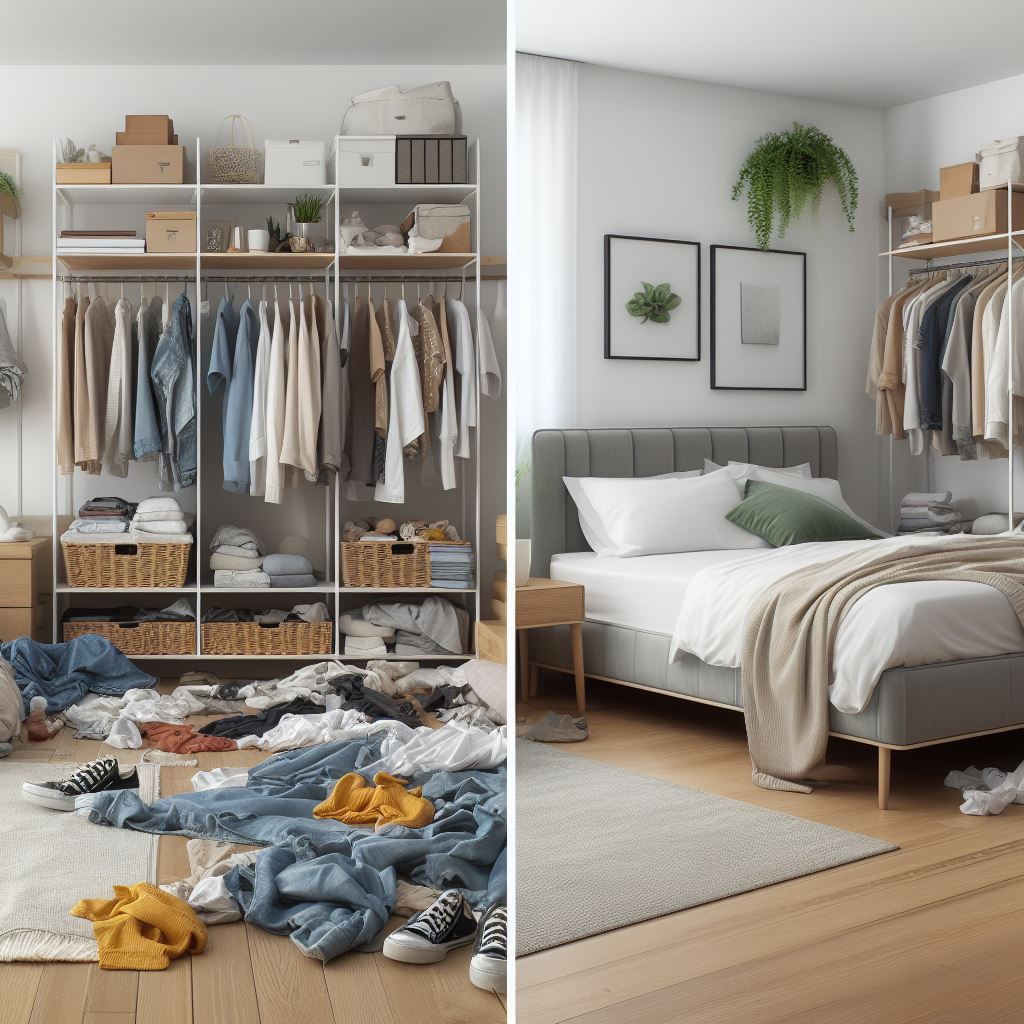Imagine coming home to a space that feels calm, organized, and free of clutter. A place where you can relax, unwind, and truly enjoy your surroundings. In this article, we will explore practical tips and strategies to help you declutter and organize your home, creating a more peaceful and harmonious environment. From creating a decluttering plan to utilizing storage solutions, you will learn how to transform your living space into a sanctuary that promotes serenity and tranquility. So, let’s embark on this journey together and discover the secrets to a clutter-free and peaceful home.
1. Assess your current situation
Take a step back and evaluate your home
To begin your decluttering journey, take a moment to step back and evaluate your home. Look at each room and assess the level of clutter and disorganization. Observe the areas that are causing you the most stress or frustration. This initial assessment will help you understand the scope of the decluttering process and provide you with a starting point.
Identify problem areas and set goals
Once you have evaluated your home, identify the problem areas that need the most attention. These could be overflowing closets, cluttered countertops, or a room filled with sentimental items. Setting goals and identifying these problem areas will give you focus and direction as you begin your decluttering journey. Whether it’s creating a more peaceful living room or a clutter-free kitchen, having specific goals in mind will motivate and guide you throughout the process.
Determine your organizing style
Understanding your organizing style can greatly assist you in creating an effective decluttering plan. Some individuals thrive in minimalist, minimal storage solutions and open spaces, while others feel more comfortable with a cozier, more eclectic approach. Reflect on how you naturally organize or envision your ideal organized space. By determining your organizing style, you can tailor your approach and make decisions that align with your preferences, making it easier to maintain an organized home in the long run.
2. Create a decluttering plan
Break down your home into manageable sections
Instead of overwhelming yourself by tackling your entire home at once, break it down into manageable sections. Begin with one room or even a specific area within a room, such as a bookshelf or a drawer. By dividing your home into smaller sections, it becomes less daunting, and you can focus on decluttering one area at a time, celebrating your progress along the way.
Set aside dedicated time for decluttering
To effectively declutter, it’s crucial to set aside dedicated time for the task. Make it a priority in your schedule, whether it’s an hour each day or a full day each week. Consistency is key. Block off this time on your calendar to ensure you have uninterrupted focus and can make significant progress in your decluttering journey.
Sort items into categories: keep, donate, discard
As you start decluttering, sort items into three categories: keep, donate, and discard. Items that you genuinely need, use, and love should be kept. Items that are no longer useful to you but may still have value can be donated to those in need. Finally, items that are broken, damaged, or no longer serve a purpose should be discarded. Separate your belongings into these categories, making it easier to free up space and let go of the things that no longer bring you joy or serve a practical purpose.
3. Start decluttering room by room
Begin with the easiest room
When embarking on your decluttering journey, it’s best to start with the easiest room. By choosing a room that requires minimal effort to declutter, you’ll experience a sense of accomplishment, which will motivate you to tackle more challenging areas. Starting with an easy room not only builds momentum but also gives you a clear picture of what an organized space can look and feel like, which can boost your motivation to continue the decluttering process.
Use the four-box method for efficient decluttering
An effective strategy for decluttering is to use the four-box method. Label four boxes as “keep,” “donate,” “sell,” and “discard.” As you go through each item in a room, make a decision about which box it belongs in. Be honest with yourself and consider whether you genuinely need, use, or love the item. This method helps streamline the decision-making process and allows you to visibly see what items will stay in your home and what will be removed.
Tackle sentimental items with care
Sentimental items can often be the most challenging to declutter. These items hold emotional value and can create a sense of attachment. When faced with sentimental items, take your time and approach them with care. Consider what truly matters to you and which items hold the most significant memories. It’s essential to strike a balance between honoring the past and creating a more peaceful and clutter-free home. If possible, take photos or keep a small representative token of the sentimental item to help preserve the memories without cluttering your space.

4. Establish an organization system
Invest in storage solutions
Investing in storage solutions can greatly assist in maintaining an organized home. Consider purchasing containers, bins, shelving units, or furniture with built-in storage. Look for items that align with your organizing style and the specific needs of each room. Storage solutions not only help reduce visual clutter but also provide designated spaces for your belongings, making it easier to find and store items efficiently.
Assign a home for every item
To maintain an organized home, it’s important to assign a home for every item. Give each item a designated space where it will reside when not in use. When every item has a specific place to return, it becomes easier to put things away and avoid clutter accumulation. Make sure the locations you assign to items are logical and easily accessible, ensuring convenience and seamless organization.
Label and categorize belongings
Labeling and categorizing your belongings can significantly enhance your organization system. Use labels or clear containers to categorize items, making it easier to find what you need when you need it. Whether it’s labeling kitchen spices or categorizing clothing by season and style, creating visual cues through labeling helps eliminate the guesswork and maintains an efficient and clutter-free home.
5. Streamline your possessions
Adopt a minimalist mindset
Adopting a minimalist mindset can transform your decluttering and organizing efforts. Embrace the philosophy of “less is more” and carefully consider the value and purpose of each possession. Focus on quality over quantity – keep items that bring you joy, serve a practical purpose or have significant sentimental value. A minimalist home allows for easier maintenance, a sense of calm, and fosters a more peaceful living environment.
Downsize your wardrobe
One area where many people accumulate clutter is their wardrobe. Take the time to go through your clothes and downsize your wardrobe. Donate or discard items that no longer fit, are damaged, or haven’t been worn in a long time. Embrace a capsule wardrobe approach, where you curate a collection of timeless and versatile pieces. This streamlining process not only simplifies getting dressed but also creates a sense of space and organization in your closet.
Limit the number of decor items
While it’s tempting to display numerous decor items in your home, limiting their number can create a more peaceful living environment. Choose a few meaningful decor pieces that truly resonate with you and bring you joy. By focusing on quality over quantity, you’ll create visually pleasing spaces that are easier to clean and maintain.
6. Develop maintenance habits
Practice regular decluttering sessions
To prevent the accumulation of clutter, practice regular decluttering sessions. Set aside time periodically to reassess your belongings and identify any areas where clutter may be starting to creep in. This could be a monthly or seasonal decluttering session where you go through your home and determine if any items can be donated, discarded, or reorganized. Regular decluttering keeps your home feeling fresh and clutter-free.
Implement daily tidying routines
In addition to regular decluttering sessions, implement daily tidying routines to maintain an organized home. Allocate a few minutes each day to tidy up your living spaces, whether it’s making the bed, putting away dishes, or organizing the entryway. Develop habits that ensure items are put back in their designated homes, reducing the likelihood of clutter accumulating.
Avoid impulsive purchases
One of the most effective ways to maintain a clutter-free home is to avoid impulsive purchases. Before buying an item, consider its value and purpose in your life. Ask yourself if it aligns with your organizing style and if it’s an essential addition to your home. By being mindful of your purchases, you can prevent unnecessary clutter from entering your space.
7. Optimize storage space
Utilize vertical storage
Utilizing vertical storage is a practical way to maximize space in your home. Install shelves or wall-mounted organizers to take advantage of vertical space in rooms such as the kitchen or garage. By using wall space, you can free up valuable floor or countertop space and create a more efficient and organized environment.
Maximize closet space with organizing tools
Closets are often a prime area for clutter and disorganization. Maximize your closet space by using organizing tools such as hanging organizers, shoe racks, or collapsible storage bins. Utilize space-saving hangers to maximize hanging space and consider adding a second clothing rod for added storage. By optimizing your closet space, you’ll be able to easily find and access your items, streamlining your daily routine.
Utilize under-bed and over-door storage
When it comes to creating storage in smaller spaces, under-bed and over-door storage can be lifesavers. Invest in under-bed storage containers to store items such as seasonal clothing, linens, or out-of-season decor. Utilize over-door organizers for shoes, accessories, or cleaning supplies. These often underutilized spaces provide additional storage without taking up valuable floor or wall space.
8. Create a relaxing bedroom
Clear clutter from surfaces
A cluttered bedroom can significantly impact your ability to relax and unwind. Clear clutter from surfaces such as nightstands, dressers, or vanities. Keep only essential items on display, such as a lamp, a book, or a few favorite photographs. By creating clean and clutter-free surfaces, you’ll foster a more peaceful and serene atmosphere in your bedroom.
Organize clothing and accessories
Maintaining an organized wardrobe not only saves you time but also contributes to a more serene bedroom environment. Organize your clothing by category (e.g., shirts, pants, dresses) and consider arranging items by color or season. Utilize dividers or drawer organizers to keep smaller items, such as socks or accessories, in order. By implementing these organization techniques, you’ll find getting ready in the morning a more enjoyable experience.
Keep the bedroom a tech-free zone
The bedroom should be a sanctuary, a place free from distractions and screens. Make a conscious effort to keep the bedroom a tech-free zone, removing any TVs, laptops, or tablets. This creates a space dedicated to rest and relaxation, allowing your mind to unwind and promote better sleep. Store electronic devices in a designated area outside the bedroom, reducing the temptation to engage with them before bedtime.
9. Streamline the kitchen
Purge expired and unused pantry items
Start streamlining your kitchen by purging expired and unused pantry items. Take a thorough inventory and discard any expired foods or items you no longer use. Consider donating non-perishable items that are still within their expiration date but do not fit your dietary preferences. By clearing out your pantry, you’ll create space for items you genuinely need and use, as well as promote a more organized and efficient cooking experience.
Organize kitchen cabinets and drawers
Organizing your kitchen cabinets and drawers can make a significant difference in your daily routine. Start by categorizing items and assigning them specific locations within your cabinets and drawers. Keep frequently used items easily accessible and store lesser-used items in less readily accessible areas. Utilize drawer dividers, shelf risers, or Lazy Susans to maximize space and keep items visible and organized.
Implement a clutter-free countertop policy
Countertop clutter can make cooking and food preparation tasks feel overwhelming. Implement a clutter-free countertop policy by only keeping essential items, such as appliances you use daily, on display. Store other appliances or items that are not regularly used in designated cabinets or pantry space. Clear countertops provide a sense of order and allow for more efficient meal prep and cleaning.
11. Maintain a clutter-free lifestyle
Adopt a mindful shopping approach
To maintain a clutter-free lifestyle, adopt a mindful shopping approach. Before making a purchase, consider if the item aligns with your organizing style, if you genuinely need it, and if it adds value to your life. By being intentional with your purchases, you can avoid accumulating unnecessary clutter and ensure that the items you bring into your home contribute to creating a more peaceful and organized living environment.
Schedule regular decluttering sessions
To prevent clutter from re-accumulating, schedule regular decluttering sessions. Plan dedicated time each month or season to reassess your belongings, purge items that no longer serve a purpose, and reorganize as necessary. By setting aside specific decluttering time, you’ll stay organized and prevent clutter from taking over your home once again.
Prioritize experiences over material possessions
Finally, prioritize experiences over material possessions. Instead of focusing on acquiring more things, divert your attention to creating memories and engaging in meaningful activities. This shift in mindset encourages a more minimalist lifestyle and reduces the desire for excessive possessions. By prioritizing experiences, you’ll find greater satisfaction and fulfillment, resulting in a more peaceful and clutter-free life.
By following these tips and taking a comprehensive approach to decluttering and organizing your home, you can create a more peaceful and serene living environment. Remember, this process takes time, so be patient with yourself and celebrate each step towards a clutter-free lifestyle. Trust that the efforts you put into decluttering and organizing will result in a more enjoyable and balanced life.




